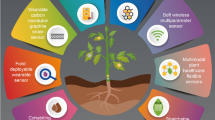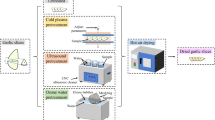Abstract
Second-order polynomial models were used to relate the independent variables, temperature, relative humidity and storage time, to the quality attributes (electrolyte leakage, chlorophylls, weight loss, humidity and headspace gas composition inside packages before and after packaging) of ready-to-eat spinach leaves. Results show that while waiting for processing the best conditions to assure high quality spinach leaves before packaging were 4 °C, 83 % RH and 4 h. The weight loss of spinach leaves was time-dependent: increasing the exposure time under these conditions decreased the amount of wet leaves before packaging. Under the same conditions, the electrolyte leakage was lower (4.63 %) and the chlorophyll content (45.44) was higher. After packaging and while waiting for dispatch, temperature most affected the package headspace atmosphere. Indeed, an increase in storage temperature from 3 to 7 °C led to a significant increase in respiration. The best combination of conditions in the high-care room was 3 °C, 74 % relative humidity for a maximum of 1 day before dispatch. In this case, the moisture content (0.46 %) and electrolyte leakage (4.16 %) were lower and the chlorophyll content (43.37) and oxygen concentration inside the packages of ready-to-eat spinach leaves (19.55 kPa) were higher.



Similar content being viewed by others
References
Bajji, M., Kinet, J.-M., & Lutts, S. (2002). The use of the electrolyte leakage method for assessing cell membrane stability as a water stress tolerance test in durum wheat. Plant Growth Regulation, 36, 61–70.
Balasubramaniam, S., & Willis, A. (1969). Stomatal movements and rates of gaseous exchange in excised leaves of Vicia faba. New Phytologist, 68, 663–674.
Bergquist, S. Å., Gertsson, U. E., & Olsson, M. E. (2006). Influence of growth stage and postharvest storage on ascorbic acid and carotenoid content and visual quality of baby spinach (Spinacia oleracea L.). Journal of the Science of Food and Agriculture, 86, 346–355.
Brecht, J. K. (1995). Physiology of lightly processed fruits and vegetables. Hortscience, 30, 18–22.
Burton, W. G. (1982). Post-harvest physiology of food crops. Longman Group Ltd.
Cantwell, M., Rovelo, J., Nie, X., & Rubatzky, V. (1998). Specialty salad greens: postharvest physiology and shelf-life. Acta Horticulturae, 371–378.
Conte, A., Conversa, G., Scrocco, C., Brescia, I., Laverse, J., Elia, A., & Del Nobile, M. A. (2008). Influence of growing periods on the quality of baby spinach leaves at harvest and during storage as minimally processed produce. Postharvest Biology and Technology, 50, 190–196.
Fan, X., & Sokorai, K. J. B. (2005). Assessment of radiation sensitivity of fresh-cut vegetables using electrolyte leakage measurement. Postharvest Biology and Technology, 36, 191–197.
Galindo, F. G., Elias, L., Gekas, V., Herppich, W. B., Smallwood, M., Sommarin, M., Worrall, D., & Sjöholm, I. (2005). On the induction of cold acclimation in carrots (Daucus carota L.) and its influence on storage performance. Food Research International, 38, 29–36.
Garrido, Y., Tudela, J. A., & Gil, M. I. (2015). Time of day for harvest and delay before processing affect the quality of minimally processed baby spinach. Postharvest Biology and Technology, 110, 9–17.
Garty, J., Weissman, L., Tamir, O., Beer, S., Cohen, Y., Karnieli, A., & Orlovsky, L. (2000). Comparison of five physiological parameters to assess the vitality of the lichen Ramalina lacera exposed to air pollution. Physiologia Plantarum, 109, 410–418.
Guerzoni, M. E., Gianotti, A., Corbo, M. R., & Sinigaglia, M. (1996). Shelf-life modelling for fresh-cut vegetables. Postharvest Biology and Technology, 9, 195–207.
Hodges, D. M., Forney, C. F., & Wismer, W. (2000). Processing line effects on storage attributes of fresh-cut spinach leaves. Hortscience, 35, 1308–1311.
Huyskens-Keil, S., & Schreiner, M. (2004). Quality dynamics and quality Assurance of Fresh Fruits and Vegetables in pre- and postharvest. In R. Dris & S. M. Jain (Eds.), (pp. 401–449). Springer Netherlands: Production Practices and Quality Assessment of Food Crops.
Kader, A. A. (2002). Biology and technology: an overview. Postharvest Technology Horticultura Crops, 3311, 39–48.
Lewicki, P. P. (1998). Effect of pre-drying treatment, drying and rehydration on plant tissue properties: a review. International Journal of Food Properties, 1, 1–22.
Limbo, S., & Piergiovanni, L. (2006). Shelf life of minimally processed potatoes: part 1. Effects of high oxygen partial pressures in combination with ascorbic and citric acids on enzymatic browning. Postharvest Biology and Technology, 39, 254–264.
Limbo, S., & Piergiovanni, L. (2007). Minimally processed potatoes: part 2. Effects of high oxygen partial pressures in combination with ascorbic and citric acid on loss of some quality traits. Postharvest Biology and Technology, 43, 221–229.
Medina, M. S., Tudela, J. A., Marín, A., Allende, A., & Gil, M. I. (2012). Short postharvest storage under low relative humidity improves quality and shelf life of minimally processed baby spinach (Spinacia oleracea L.). Postharvest Biology and Technology, 67, 1–9.
Ozkan, I. A., Akbudak, B., & Akbudak, N. (2007). Microwave drying characteristics of spinach. Journal of Food Engineering, 78, 577–583.
Pandrangi, S., & LaBorde, L. (2004). Retention of folate, carotenoids, and other quality characteristics in commercially packaged fresh spinach. Journal of Food Science, 69, 702–707.
Saenmuang, S., Al-Haq, M., Samarakoon, H., Makino, Y., Kawagoe, Y., & Oshita, S. (2012). Evaluation of models for spinach respiratory metabolism under low oxygen atmospheres. Food and Bioprocess Technology, 5, 1950–1962.
Saltveit, M. E. (2002). The rate of ion leakage from chilling-sensitive tissue does not immediately increase upon exposure to chilling temperatures. Postharvest Biology and Technology, 26, 295–304.
Suich, R., & Derringer, G. C. (1980). Is the regression equation adequate?—a further note. Technometrics, 22, 125–126.
Tano, K., Oulé, M. K., Doyon, G., Lencki, R. W., & Arul, J. (2007). Comparative evaluation of the effect of storage temperature fluctuation on modified atmosphere packages of selected fruit and vegetables. Postharvest Biology and Technology, 46, 212–221.
Tietel, Z., Lewinsohn, E., Fallik, E., & Porat, R. (2012). Importance of storage temperatures in maintaining flavor and quality of mandarins. Postharvest Biology and Technology, 64, 175–182.
USDA (United States Department of Agriculture) (1987) Soil mechanics level I-module 3: USDA textural classification study guide. National Employee Development Staff, Soil Conservation Service, USDA.
Watada, A., Kim, S. D., Kim, K. S., & Harris, T. C. (1987). Quality of green beans, bell peppers and spinach stored in polyethylene bags. Journal of Food Science, 52, 1637–1641.
Acknowledgments
The work was financially supported by Vitacress Portugal SA through project SETIF 0.004/2015 – New solutions to improve postharvest processability and quality of leafy vegetables. This work was also supported by FCT - Fundação para a Ciência e a Tecnologia through project UID/Multi/50016/2013.
Author information
Authors and Affiliations
Corresponding author
Rights and permissions
About this article
Cite this article
Oliveira, A., Castro, P.M., Amaro, A.L. et al. Optimization of Temperature, Relative Humidity and Storage Time before and after Packaging of Baby Spinach Leaves Using Response Surface Methodology. Food Bioprocess Technol 9, 2070–2079 (2016). https://doi.org/10.1007/s11947-016-1785-z
Received:
Accepted:
Published:
Issue Date:
DOI: https://doi.org/10.1007/s11947-016-1785-z




